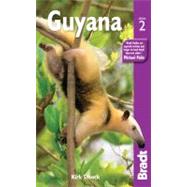
The New copy of this book will include any supplemental materials advertised. Please check the title of the book to determine if it should include any access cards, study guides, lab manuals, CDs, etc.
The Used, Rental and eBook copies of this book are not guaranteed to include any supplemental materials. Typically, only the book itself is included. This is true even if the title states it includes any access cards, study guides, lab manuals, CDs, etc.
Most lodges are small, family- or community-run affairs that welcome visitors as old friends. Expect to be called by your first name, often upon arrival, and to be remembered should you ever return. Tourism in Guyana is different from most places; it’s far from polished and can entail hiccups. But it’s exactly this unpolished and unpretentious tourism that creates a unique experience that often leaves visitors feeling as though they have stumbled upon a rare, nearly undiscovered tourism gem.
Towards the end of my own travels researching this book I visited Shell Beach, and during one afternoon I walked the endless beach alone for an hour before sitting down to write. I noted that I was on the northern coast of South America, waves of the Atlantic lapping at my feet, a wall of coconut palms to my back and the tracks left from a nesting green sea turtle on my right.
There was no sign of civilization in any direction and for the umpteenth time during my travels in Guyana I felt as though I had stepped into something larger than the present, something that diminishes all that mankind has created in this world, both good and bad. It was nature, in a raw, unaltered, almost timeless state that made me feel insignificant. It was a welcome and humbling feeling.
It’s this sense of experiencing a rare natural world that I associate with travelling in Guyana. The pristine nature, the rich biodiversity, the endangered species, the incredibly varied ecosystems: they’re all here, but there is always an underlying threat posed by the immediate gains of development and exploitation of natural resources.
Guyana is thankfully increasingly looking to ecotourism as an economically feasible way of conserving and preserving the country’s natural riches. Many Amerindian communities are turning away from the wildlife trade, mining and forestry and looking at tourism as a means of bringing income to their villages while preserving their resources for future generations.
The communities are told over and over that they have all of the necessary components to create an ideal ecotourism destination. Lodges are built, trails are cut and guides are trained. During my visits to community tourism projects I found myself fielding similar questions from those who run them: What are we doing wrong? Why aren’t we getting many visitors?
Indeed, they are doing nothing wrong. The guides are excellent, the lodges comfortable, the nature pristine; everything is in place. The problem is that Guyana remains a virtual unknown. Villages and people can’t depend on tourism without enough visitors to make it possible. I only hope that this book will arouse a bit of interest in Guyana and cause others to take a chance and veer off the beaten path on their next holiday.